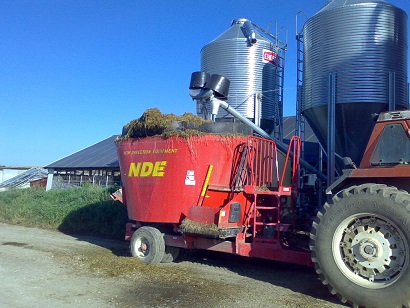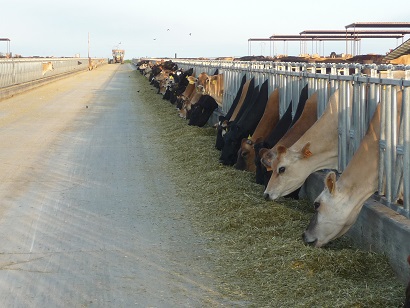Common mistakes affecting TMR mixing process. Interview to Felix Soriano (APN Consulting, USA)
Published: November 14, 2013
By: Engormix
 Felix Soriano, President and founder of APN Consulting, has more than 10 years of experience working with dairy producers and has dedicated his career to developing tools and programs to improve dairy performance and profitability. He was invited to the Animal Nutrition Congress organized by CAENA, September 2013 in Argentina to give a talk about Human Resources in Dairy Farming Systems.
Felix Soriano, President and founder of APN Consulting, has more than 10 years of experience working with dairy producers and has dedicated his career to developing tools and programs to improve dairy performance and profitability. He was invited to the Animal Nutrition Congress organized by CAENA, September 2013 in Argentina to give a talk about Human Resources in Dairy Farming Systems. In your talk you mentioned most common issues that affect the TMR mixing process, and one of them was to have poor mixer and equipment maintenance. What would be the consequences and what are your recommendations?
A lack of protocols and schedules for equipment maintenance can lead to many problems. An example is when the mixer has dull knives because they are not being sharpened or changed frequently. This leads to a mixer that cannot process hay properly. This is especially important when hay is an important part of the diet. Another example can be having dull kicker plates that are not close enough to the mixer wall. This can create mixing problems due to the presence of dead spots inside the mixer where feed doesn't get properly mixed. So I suggest:
- Talk to your equipment dealer to find out about the best maintenance program for your equipment.
- Develop a maintenance protocol and a schedule for changing or working on knives, kicker plates, filters, etc.
- Assign someone to be in charge of the maintenance program and held him/her accountable
How important is to have the proper loading sequence? What would you say to the farmer?
Loading sequence is critical for the proper mixing of all ingredients. Improper loading sequence will cause variability in the TMR. Sometimes, due to incorrect loading sequence, forages don’t get processed enough, or small inclusion rate ingredients are not blend uniformly. So Work with your nutritionist, external consultant and feeders to evaluate and define the best loading sequence, based on the type of mixer, forages and ingredients used at your dairy. The loading sequence may need to be re-evaluated if ingredients used in the diet change.
You also pointed out that not having the adequate equipment for the type of mixer could be a problem. Would you give us some examples and solutions to each problem?
A few examples of this are:
A. Tractor doesn’t have enough power for the size of mixer (usually it’s a vertical mixer, twin or three screws), run at low RPM’s because the tractor doesn’t have enough power.
As a result, the TMR is inconsistent and materials don’t mix properly, in spite of increasing the mixing time per load (sometimes more than 30 minutes).
1) Prepare smaller batches of feed (if you have enough time during the day).
2) Ask the right questions before buying a new mixer to ensure it is the correct one for the type of equipment you have.
3) Buy a bigger tractor.
2) Ask the right questions before buying a new mixer to ensure it is the correct one for the type of equipment you have.
3) Buy a bigger tractor.

B) The mixer cannot process hay or straw (most commonly seen with reel type or some horizontal auger type mixers). While it’s not a problem if you don’t feed hay or straw, it can become a problem if your nutritionist or veterinarian recommends adding hay or straw to the diet. When this happens, the TMR has big chunks of unprocessed, improperly mixed hay or straw. Cows sort what they want to eat, leading to more cases of subclinical acidosis, or more DA’s in fresh cows, in spite of all the good “scratchy” forage that’s in the diet.
1) Long particle size forages must be pre-processed before loading in the mixer.
2) You may also need to feed less of these long particle size forages to improve TMR uniformity.
2) You may also need to feed less of these long particle size forages to improve TMR uniformity.
C. Mixer is too small so the mixer is always overloaded when feeding the largest pens. As a result, the ration is always variable. A good indicator of this is when we see unmixed material in the feed bunk (i.e.: big chunks of hay; more steam flaked corn in some sections of the feed bunk than in others; TMR is wetter in some sections than in others because the whey, water or liquid molasses not getting properly mixed throughout the entire batch).
1) Make two batches of feed instead of one for the largest pens, or three instead of two, or four instead of three (you know what I mean). Depending on the type of mixer, never go above 95% of struck capacity for vertical mixers, 75% for horizontal auger mixers, and 70% for reel type mixers.
Would you tell us about the risks of inconsistent mixing times and what should be done to avoid this?
For the same feed, mixing time should be exactly the same, every time. Often, because the feeder is on the phone or distracted by another employee, a batch that should have been mixed 15 minutes is mixed 25 minutes or more instead. Other times, because of lack of protocols, the feeder leaves the mixer running while he goes to get more hay or straw for the next batch, extending mixing time. Needles to say, due to extended mixing time, that batch will be different than the previous one. Consequently, the pen fed the last load will get a ration with overprocessed forages, increasing risk of causing rumen health problems.
One solution would be to monitor feeders performance by using feeding management software and give them more and better feedback. Also to develop feeding protocols and spend time and money training your feeders. Explain the ”why” of things, reminding them about the importance of their role for the dairy’s profitability, and the importance of being consistent are critical.

Finally, why is it important to address forage variability immediately?
This is common to see when feeders don’t pay attention to details or don’t communicate well with their supervisors. Maybe the hay quality has changed, or the haylage pile is now more wet or just looks different and the feeder doesn’t notice the difference, or does but doesn’t do anything about it. Many times, lack of proper training or lack of communication with the feeders is the cause of this. The lack of attention to forage and ingredient changes can cause simple, but yet expensive problems like a drop in milk production, or more serious health and fertility issues like the ones caused by mycotoxin contamination of forages, or butyric fermentation of silage fed to cows even for just a few days.
So training and coaching your feeders is crucial. Your feeder must realize immediately when forages or any other ingredient changes. Formal training of what to look for in forages and ingredients, how to communicate when forages change, and running dry matters using a Koster tester are a critical part of the success of your feeding program.
Evaluate these common variables of the mixing process at your own dairy, and make sure you aren’t having any of these issues. Get outside support from your consultants to coach and train your feeders to avoid some of these common problems during the mixing process.
To watch Felix Soriano´s lecture in Spanish at CAENA, please click here
Source
EngormixRecommend
Comment
Share

Would you like to discuss another topic? Create a new post to engage with experts in the community.






